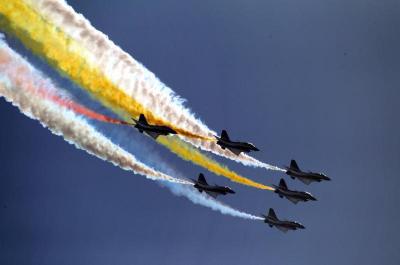The US is cranking up its sixth-generation fighter program with a sense of urgency driven by multiple issues that are weighing against its dominant position in fighter technology and air superiority.
This month, The Warzone reported that the competition to produce the US Next Generation Air Dominance (NGAD) fighter has likely been narrowed down to three contractors – Lockheed Martin, Boeing, and Northrop Grumman, the US aerospace industry’s heavyweights.
The report notes that the final decision on what is assumed to be a winner-take-all competition is expected next year. Intriguingly, it is believed that there are now at least three NGAD technology demonstrator aircraft in existence.
Although there is no consensus on what constitutes a sixth-generation fighter, the type will likely feature new and emerging technologies such as modular design, machine learning, artificial intelligence, virtual and augmented reality, drone swarms and optionally-manned capability.
While there have been many sixth-generation fighter design concepts, a key feature of the class may be a lack of moving control surfaces to preserve carefully laid out stealth shaping.
Asia Times reported in January 2023 that the US Defense Advanced Research Projects Agency (DARPA) and Aurora Flight Sciences have been developing the Control of Revolutionary Aircraft with Novel Effector (CRANE) X-Plane program, with a flight demonstration expected in 2025.
The project features a technology known as Active Flow Control (AFC), which maneuvers the aircraft using jets of high-pressure air from actuators embedded in the aircraft’s body instead of traditional mechanical control surfaces.
The CRANE X-Plane program also has interchangeable wings and actuator technology, meaning the core technologies can be tested between Aurora and other aerospace firms like Lockheed Martin, Boeing and Northrop Grumman.

The NGAD will likely feature AFC technology alongside thrust vectoring to preserve stealth and increase maneuverability. Moving control surfaces an aircraft’s shape, influencing how radar returns are generated and possibly compromising stealth.
Eliminating those moving surfaces may remove a critical vulnerability of current-generation stealth fighters, allowing the next-generation to continue operating in heavily defended airspace.
The race to field sixth-generation fighters has become more urgent for the US considering the relative obsolescence of even its latest fighters, the shifting balance of airpower toward China, and Beijing’s recent advances in sixth-generation fighter technology.
Asia Times noted in May 2023 that the US’ top-of-the-line F-22 faces obsolescence, cost death spiral and impractical upgrades, which makes designing an all-new aircraft more feasible than keeping the late 1990s type in service.
Since F-22 production was halted in 2009 with just 186 planes, its production lines have been cannibalized to make way for the F-35, which is more flexible but needs to be optimized for air superiority. That also means that each F-22 is irreplaceable, with many sensitive components no longer manufactured.
The proposed retirement of 33 F-22 Block 20 fighters will cut into an already small fleet, with the older F-22 models potentially no longer competitive against newer Chinese fighters such as the J-20. The older F-22 Block 20 fighters are reportedly so out of sync with the newer, combat-coded F-22 Block 35s that they are limited to use only as trainers.
China has fielded the HQ-9 surface-to-air missile (SAM) and J-20 stealth fighters to blunt the US strategy of penetrating air defenses to attack sensitive targets such as airfields, logistics facilities, and command and control centers.
In addition, the F-22 lacks infrared search and track (IRST) capability, a critical passive sensor capability to maintain stealth while in combat. While that capability is now belatedly retrofitted on F-22s, an external IRST pod upgrade could upset the F-22’s carefully laid-out stealth shaping, with the upgrade’s cooling systems taking up valuable internal space for future upgrades.
Asia Times reported in September 2022 that China’s fighter force may have already caught up with the US in terms of quantity and quality. Indeed, the era of US conventional overmatch may already have ended with US combat air forces now less than half of what they were during the 1991 Gulf War.
While the US Air Force requires 60 fighter squadrons, it now has just 48, with the fighter shortage most acutely felt in the Pacific where the US needs 13 squadrons but has just 11. Only three of eight squadrons are transitioning to newer aircraft, adding to obsolescence concerns.

Aging aircraft are also a concern, with the average US fighter now 32 years old and with pilots flying barely once a week, implying a fighter force that is smaller, older and less capable. Moreover, Asia Times reported in October 2022 that China is moving quickly to develop a NGAD rival, mirroring the same system-of-systems approach used by the US.
The US now maintains a very narrow lead in sixth-generation fighter development, with the US possibly getting its first such fighter just a month before China. China also uses an incremental approach in its sixth-generation fighter program, in contrast to the technology leapfrogging approach the US favors.
China could incrementally upgrade its J-20 fifth-generation fighter as the basis for its next-generation jet, incorporating technologies found in sixth-generation fighters such as directed energy weapons or optionally-manned capability.
While limitations in jet engine technology have handicapped China’s jet fighters, that too could be changing. China’s new WS-15 turbofan engine is slated to replace all Russian-made AL-31F engines in its J-20 fleet, showing China’s growing confidence in its metallurgy and jet engine manufacturing methods and capabilities.

